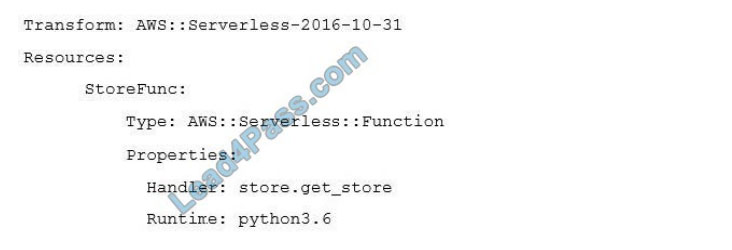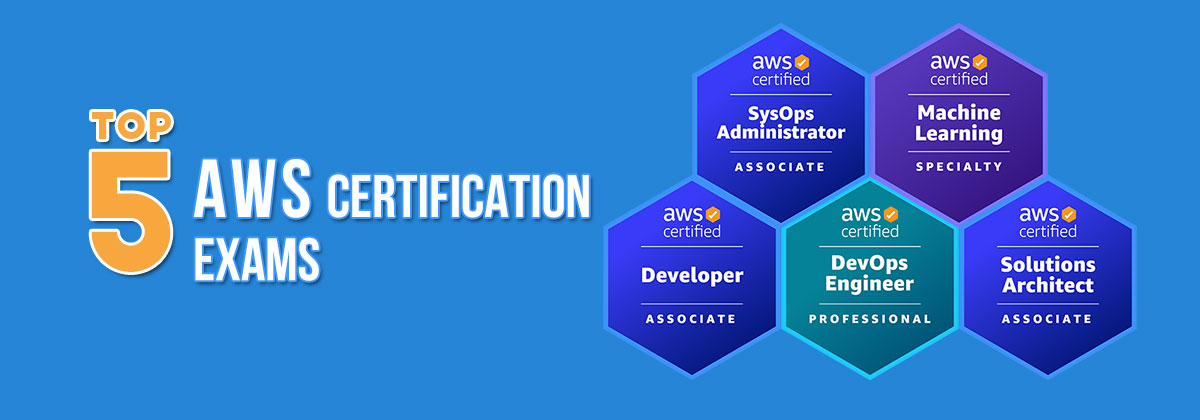DVA-C01 Dumps V14.02 is the latest version of leads4pass DVA-C01 Dumps, a truly effective solution for the AWS Certified Developer – Associate exam.
The DVA-C01 Dumps V14.02 version has updated all previous exam questions and answers. The latest DVA-C01 exam questions and answers have been verified and verified by Amazon subject matter experts, and are true and valid.
Download the latest AWS Certified Developer – Associate exam questions and answers on the Lead4Pas DVA-C01 Dumps page https://www.leads4pass.com/aws-certified-developer-associate.html,
leads4pass provides two study tools, PDF and VCE, to facilitate you to study easily, improve your progress quickly, and guarantee your first attempt at the AWS Certified Developer – Associate exam solution to be successful.
DVA-C01 Exam Information:
You should know that DVA-C01 is the exam code for the AWS Certified Developer – Associate exam, one of the AWS Certified Associate certifications, see the following for more basic information:
Vendor: Amazon
Exam Code: DVA-C01
Exam Name: AWS Certified Developer – Associate (DVA-C01)
Certification: AWS Certified Associate
Length: 130 minutes to complete the exam
Cost: 150 USD
Format: 65 questions, either multiple choice or multiple responses
languages: English, French (France), German, Italian, Japanese, Korean, Portuguese (Brazil), Simplified Chinese, and Spanish (Latin America)
For newbies you need to know these:
AWS Certified Developer – Associate is intended for anyone with one or more years of hands-on experience developing and maintaining an AWS-based application.
Before you take this exam, we recommend you have:
The threshold for the Amazon certification exam is relatively high. If you are a rookie, you must meet the conditions mentioned in the following photos. If you meet any conditions, please continue to read.

But whether you are a rookie or a DVA-C01 candidate, please continue reading, and there are free surprises:
DVA-C01 Free Dumps Read Online:
QUESTION 1:
An international e-commerce company\’s website encourages customers to leave reviews of products that they have purchased. Products are seasonal. The products are popular for a short period of time and then are not popular in the next season.
Customers leave the reviews in their native language. A developer is using Amazon Translate to implement a new feature to translate the reviews into other languages for customers who speak different languages. The website has hundreds of thousands of products with millions of reviews and is growing. Most reviews will be viewed in only two or three languages.
What is the MOST cost-effective way to implement this new feature?
A. Update the application code that writes the review to the database to translate the review into all supported languages. Persist a copy of each translation in the database for future visitors.
B. Update the application code that reads the review from the database to check an Amazon ElastiCache cluster for translated reviews. If a visitor is requesting a review and language combination that is not in the cache, configure the application to translate it and store it in the cache with a TTL of 1 month.
C. Update the application code that reads the review from the database to translate the review in real-time and return the translated version without persisting it.
D. Set up a database change stream to write events to a stream each time a customer writes a review. Configure an AWS Lambda function to read the events from the stream, translate the review into all supported languages, and update the review database to include all translations for future visitors.
Correct Answer: D
Reference: https://docs.aws.amazon.com/lambda/latest/dg/with-ddb.html
QUESTION 2:
Where can PortMapping be defined when launching containers in Amazon ECS?
A. Security groups
B. Amazon Elastic Container Registry (Amazon ECR)
C. Container agent
D. Task definition
Correct Answer: D
QUESTION 3:
A developer is writing code for an AWS Lambda function. The function will be used as a Lambda authorizer so that.
Amazon API Gateway can control access to a specific API.
What should this code return in addition to the principal identifier upon successful authentication?
A. An HTTP response status code of 200 that indicates successful completion
B. An integer 0 that indicates successful completion
C. The Amazon Resource Name (ARN) of an IAM role that will be assumed for authentication
D. A policy document with desired permissions
Correct Answer: C
Reference: https://www.alexdebrie.com/posts/lambda-custom-authorizers/
QUESTION 4:
A developer at a company writes an AWS ClojdForination template. The template refers to subnets that were created by a separate AWS Cloud Formation template that the company\’s network team wrote. When the developer attempts to launch the stack for the first time, the launch fails.
Which template coding mistakes could have caused this failure? (Select TWO.)
A. The developer\’s template does not use the Ref intrinsic function to refer to the subnets
B. The developer\’s template does not use the ImportValue intrinsic function to refer to the subnets
C. The Mappings section of the developer\’s template does not refer to the subnets.
D. The network team\’s template does not export the subnets in the Outputs section
E. The network team\’s template does not export the subnets in the Mappings section
Correct Answer: BD
QUESTION 5:
A Developer is working on an application that tracks hundreds of millions of product reviews in an Amazon DynamoDB table. The records include the data elements shown in the table:

Which field, when used as the partition key, would result in the MOST consistent performance using DynamoDB?
A. starRating
B. reviewID
C. comment
D. productID
Correct Answer: D
Refer AWS documentation – DynamoDB Design partition key
The partition key portion of a table\’s primary key determines the logical partitions in which a table\’s data is stored.
This in turn affects the underlying physical partitions. Provisioned I/O capacity for the table is divided evenly among these physical partitions. Therefore a partition key design that doesn\’t distribute I/O requests evenly can create “hot” partitions that result in throttling and using your provisioned I/O capacity inefficiently.
The optimal usage of a table\’s provisioned throughput depends not only on the workload patterns of individual items but also on the partition-key design. This doesn\’t mean that you must access all partition key values to achieve an efficient throughput level, or even that the percentage of accessed partition key values must be high. It does mean that the more distinct partition key values that your workload accesses, the more those requests will be spread across the partitioned space. In general, you will use your provisioned throughput more efficiently as the ratio of partition key values access to the total number of partition key values increases.
QUESTION 6:
A gaming company has deployed a web portal on AWS Elastic Beanstalk. The company sometimes needs
to deploy new versions three or four times a day. The company needs to deploy new features for all
users as quickly as possible.
The solution must minimize performance impact and must maximize availability.
What solution will meet these requirements?
A. Use a rolling deployment policy to deploy to Amazon EC2 instances.
B. Use an immutable deployment policy to deploy to Amazon EC2 instances.
C. Use an all-at-once deployment policy to deploy to Amazon EC2 instances.
D. Use a canary deployment strategy to deploy changes to Amazon EC2 instances.
Correct Answer: A
Reference: https://docs.aws.amazon.com/elasticbeanstalk/latest/dg/using-features.rolling-versiondeploy.html
QUESTION 7:
A current architecture uses many Lambda functions invoking one another as a large state machine. The coordination of this state machine is legacy custom code that breaks easily.
Which AWS Service can help refactor and manage the state machine?
A. AWS Data Pipeline
B. AWS SNS with AWS SQS
C. Amazon Elastic MapReduce
D. AWS Step Functions
Correct Answer: D
https://aws.amazon.com/step-functions/
QUESTION 8:
An application is being developed to audit several AWS accounts. The application will run in Account A and must access AWS services in Accounts B and C.
What is the MOST secure way to allow the application to call AWS services in each audited account?
A. Configure cross-account roles in each audited account. Write code in Account A that assumes those roles
B. Use S3 cross-region replication to communicate among accounts, with Amazon S3 event notifications to trigger Lambda functions
C. Deploy an application in each audited account with its own role. Have Account A authenticate with the application
D. Create an IAM user with an access key in each audited account. Write code in Account A that uses those access keys
Correct Answer: A
https://docs.aws.amazon.com/IAM/latest/UserGuide/tutorial_cross-account-with-roles.html
QUESTION 9:
A Developer is building a three-tier web application that should be able to handle a minimum of 5000 requests per minute. Requirements state that the web tier should be completely stateless while the application maintains a session state for the users.
How can session data be externalized, keeping latency at the LOWEST possible value?
A. Create an Amazon RDS instance, then implement session handling at the application level to leverage a database inside the RDS database instance for session data storage
B. Implement a shared file system solution across the underlying Amazon EC2 instances, then implement session handling at the application level to leverage the shared file system for session data storage
C. Create an Amazon ElastiCache Memcached cluster, then implement session handling at the application level to leverage the cluster for session data storage
D. Create an Amazon DynamoDB table, then implement session handling at the application level to leverage the table for session data storage
Correct Answer: C
https://aws.amazon.com/caching/session-management/
QUESTION 10:
A developer is creating a script to automate the deployment process for a serverless application. The developer wants to use an existing AWS Serverless Application Model (AWS SAM) template for the application.
What should the developer use for the project? (Choose two.)
A. Call aws cloudformation package to create the deployment package. Call aws cloudformation deploy to deploy the package afterward.
B. Call sam package to create the deployment package. Call sam to deploy to deploy the package afterward.
C. Call aws s3 cp to upload the AWS SAM template to Amazon S3. Call aws lambda update-function-code to create the application.
D. Create a ZIP package locally and call aws serverlessrepo create-application to create the application.
E. Create a ZIP package and upload it to Amazon S3. Call aws cloudformation create-stack to create the application.
Correct Answer: BC
Reference: https://docs.aws.amazon.com/serverless-application-model/latest/developerguide/serverless-gettingstarted-hello-world.html https://docs.aws.amazon.com/AWSCloudFormation/latest/UserGuide/using-cfn-cli-package.html
QUESTION 11:
A stock market monitoring application uses Amazon Kinesis for data ingestion. During simulated tests of peak data rates, the Kinesis stream cannot keep up with the incoming data.
What step will allow Kinesis to accommodate the traffic during peak hours?
A. Install the Kinesis Producer Library (KPL) for ingesting data into the stream.
B. Reduce the data retention period to allow for more data ingestion using DecreaseStreamRetentionPeriod.
C. Increase the shard count of the stream using UpdateShardCount.
D. Ingest multiple records into the stream in a single call using PutRecords.
Correct Answer: C
https://docs.aws.amazon.com/streams/latest/dev/developing-producers-with-kpl.html
QUESTION 12:
A large company has its application components distributed across multiple AWS accounts. The company needs to collect and visualize trace data across these accounts.
What should be used to meet these requirements?
A. AWS X-Ray
B. Amazon CloudWatch
C. Amazon VPC flow logs
D. Amazon Elasticsearch Service
Correct Answer: A
Reference: https://aws.amazon.com/xray/
QUESTION 13:
Given the source code for an AWS Lambda function in the local store.py containing a handler function called get_store and the following AWS CloudFormation template:

What should be done to prepare the template so that it can be deployed using the AWS CLI command aws cloudformation deploy?
A. Use aws cloudformation compile to base64 encode and embed the source file into a modified CloudFormation template.
B. Use aws cloudformation package to upload the source code to an Amazon S3 bucket and produce a modified CloudFormation template.
C. Use aws lambda zip to package the source file together with the CloudFormation template and deploy the resulting zip archive.
D. Use aws serverless create-package to embed the source file directly into the existing CloudFormation template.
Correct Answer: B
https://docs.aws.amazon.com/cli/latest/reference/cloudformation/package.html
……
DVA-C01 Free Dumps online download:https://drive.google.com/file/d/1652kdUUnJ1PBh6511kitUxpVM3jFghnB/
View 613 DVA-C01 Dumps V14.02 exam questions and answer


